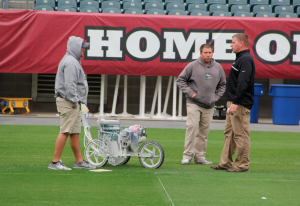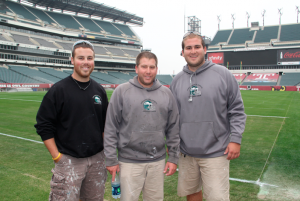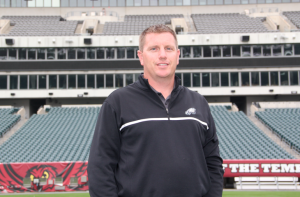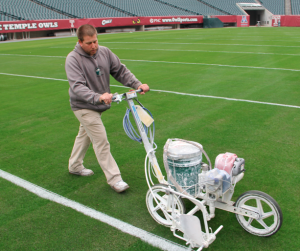Owls on Saturday, Eagles on Sunday

The Eagles keep a staff of five full-timers and two interns to keep the Eagles’ playing fields looking sharp. Photo: Philadelphia Eagles
He won’t call it “Hell week” because he’s done it so many times now that he’s gotten used to it. But Tony Leonard, director of grounds for the Philadelphia Eagles, will at least admit it’s going to be a busy weekend: the Temple Owls host Army on Saturday, then the Philadelphia Eagles host the Dallas Cowboys on Sunday.
“Obviously, if the weather gets ugly, it becomes tough,” Leonard says. “Knock on wood, we haven’t had many of those weekends where we’ve had a back-to-back and bad weather.”
To convert the field from a Temple game to an Eagles game takes about seven hours to repaint everything, Leonard estimates. His crew includes four full-time staffers and two interns from his alma mater, Penn State. Along with Lincoln Financial Field, the home field of the Eagles, Leonard is also responsible for the team’s outdoor and indoor practice fields down the street at the NovaCare Complex. (Watch a time-lapse video of the recent renovations completed at the practice facility.)
This season is the first for the Eagles to be playing on Latitude 36, a hearty cool-season bermudagrass developed by Oklahoma State University. (Previously the grasses at the stadium were Patriot, then Riviera.) Latitude 36 is also being used by the Tennessee Titans and the Washington Redskins, as well as at the Baltimore Ravens’ practice facility.

Jordan Gleim, Intern, Penn State, Chad Cochenour, Assistant Sports Field Manager and Eddie Harbaugh, Intern, Penn State, take a break for a photo at Lincoln Financial Field. Photo: Philadelphia Eagles
“When we looked at going to bermudagrass, we looked at Purdue University. They have Patriot bermudagrass. We made a trip there, and we made the trip to Washington. We talked to the folks at the University of Tennessee, they were doing a lot of research as well as the folks at Virginia Tech,” Leonard says. “Talking to those guys, we looked at all the climates. Low temperatures at night are critical. During summer, it’ll be rare for us to get below 70 for nighttime. We hosted training camp at our practice facility for the first time — part of the reason to switch to bermuda. This year was a little wetter and cooler, but the bermuda did great.”

Tony Leonard, director of grounds, Philadelphia Eagles. “My favorite part of the job is coming to work everyday. We’re one of 32 (NFL teams). It’s awesome to be around.” Photo: Philadelphia Eagles
“The Linc” also has the benefit of a SubAir system and an underground heating system with 28 miles of piping to keep the soil temperature at whatever temp Leonard prefers. This is helpful on those back-to-back Saturday/Sunday game weekends, and also helpful when the field has to go from hosting concerts or monster trucks back to withstanding 300-pound linemen.
“This year, we had back-to-back Taylor Swift concerts on July 19th and 20th, then we sodded on the 22nd and 23rd,” Leonard says. “We then held a practice on July 28th.”
Such a busy calendar makes time fly for Leonard and his crew. Now that the Eagles have added a well-known speedster in head coach Chip Kelly, things aren’t about to slow down.
“Coach Kelly is fast! Everything is fast. It is structured. All in all, it’s been fun. He brings a lot of new technologies with him, a new way of thinking. The beauty of it is he has a reason for all of it, and he’ll tell you why. I think he’s brought a scientific approach to it, which has been awesome,” Leonard says. “We’ve always monitored the fields, but now we’re monitoring them closer… just like a player and his diet — it’s been monitored, now it’s being monitored closer. Now we play music during practices. We never did that before. But there’s a reason — to keep the tempo up.”
Coach Kelly may have brought new technologies and a new way of thinking to the Eagles, but when it comes to Leonard’s job, the goal remains the same as it has always been.

Chad Cochenour paints the field for the Temple/Army game. It takes about seven hours to repaint the field for the Eagles game. Photo: Philadelphia Eagles
“All coaches want a good, safe playing field, and that’s what we provide. They let us do our job and we let them do theirs,” Leonard says. “So far so good. He’s great for the city, great for the team. But at the end of the day, you can go from professional to college to high school — all anyone wants is a good, safe playing field.”
Leonard considers the 2004 NFC Championship game — which the Eagles won over Michael Vick’s Atlanta Falcons — as his favorite moment. A foot of snow fell the day before the game, but the entire organization came together to remove the snow from the stadium.
“You go through the work, the prep, you spend 48 hours getting the field ready… and the field plays great, and we walk away from it with a win? It feels awesome,” Leonard says.
The hardest part of his job is all the planning. But it’s also what he’s good at. If it starts raining this weekend once the ball is kicked off, there’s nothing he can do. But the plan he put in place ahead of time will have him in the best position to get the field ready for the next game.
“I always tell my guys, as a turf manager, whether you’re a (golf course) superintendent or a landscape guy, anyone in the green industry — your best tool is a crystal ball and a magic wand,” he says. “That’s what you need to have. You have to look into the future and predict. You need to be able to map things and be able to pull rabbits out of your hat and make things look good.”










